Parachute

A parachute is a device used to slow the motion of an object through an atmosphere by creating drag, or in the case of ram-air parachutes, aerodynamic lift. Parachutes are usually made out of light, strong cloth, originally silk, now most commonly nylon. Parachutes must slow an object's terminal vertical speed by a minimum 75% in order to be classified as such. Depending on the situation, parachutes are used with a variety of loads, including people, food, equipment, space capsules, and bombs.
Drogue chutes are used to aid horizontal deceleration of a vehicle (a fixed-wing aircraft, or a drag racer), or to provide stability (tandem free-fall, or a space shuttle after a touchdown).
The word "parachute" comes from the French prefix paracete, originally from the Greek, meaning to protect against, and chute, the French word for "fall", and it was originally coined, as a hybrid word which meant literally "that which protects against a fall", by the French aeronaut François Blanchard (1753–1809) in 1785.
History
Early Renaissance Forms
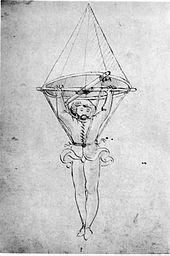
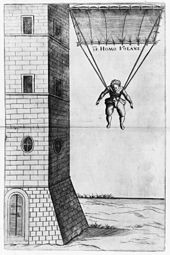
The earliest evidence for the parachute dates back to the Renaissance period.[1] The oldest parachute design appears in an anonymous manuscript from 1470s Renaissance Italy (British Museum Add. MSS 34,113, fol. 200v), showing a free-hanging man clutching a cross bar frame attached to a conical canopy.[2] As a safety measure, four straps run from the ends of the rods to a waist belt. The design is a marked improvement over another folio (189v) which depicts a man trying to break the force of his fall by the means of two long cloth streamers fastened to two bars which he grips with his hands.[3] Although the surface area of the parachute design appears to be too small to offer effective resistance to the friction of the air and the wooden base-frame is superfluous and potentially harming, the revolutionary character of the new concept is obvious.[3]
Only slightly later, a more sophisticated parachute was sketched by the polymath Leonardo da Vinci in his Codex Atlanticus (fol. 381v) dated to ca. 1485.[2] Here, the scale of the parachute is in a more favorable proportion to the weight of the jumper. Leonardo's canopy was held open by a square wooden frame, which alters the shape of the parachute from conical to pyramidal.[3] It is not known whether the Italian inventor was influenced by the earlier design, but he may have learnt about the idea through the intensive oral communication among artist-engineers of the time.[4] The feasibility of Leonardo's pyramidal design was successfully tested in 2000 by the British Adrian Nicholas and again in 2008 by another skydiver.[5] According to the historian of technology Lynn White, these conical and pyramidal designs, much more elaborate than early artistic jumps with rigid parasols in Asia, mark the origin of "the parachute as we know it".[1]
The Venetian inventor Fausto Veranzio (1551–1617) examined da Vinci's parachute sketch, and set out to implement one of his own. He kept the square frame, but replaced the canopy with a bulging sail-like piece of cloth which he came to realize decelerates the fall more effectively.[3] A now-famous depiction of a parachute that he dubbed Homo Volans (Flying Man) appeared in his book on mechanics, Machinae Novae (1615 or 1616), alongside a number of other devices and technical concepts. It is widely believed that in 1617, Veranzio implemented his design and tested the parachute by jumping from St Mark's Campanile in Venice and that the event was documented some thirty years later by John Wilkins, founder and secretary of the Royal Society in London in his book Mathematical Magick or, the Wonders that may be Performed by Mechanical Geometry, published in London in 1648. However, in this book, John Wilkins wrote about flying, not about parachutes. He neither mentions Fausto Veranzio nor a parachute jump nor any event in 1617. Furthermore, the story does not explain how Veranzio could have managed to get the wooden frame out of the tower and into a horizontal position with himself underneath without the device tilting and collapsing. No evidence has been found that anyone ever tested Veranzio's parachute.[6]
Modern parachutes
This section needs additional citations for verification. (January 2009) |


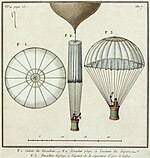


18th and 19th centuries
The modern parachute was invented in the late 18th century by Louis-Sébastien Lenormand in France, who made the first recorded public jump in 1783. Lenormand also sketched his device beforehand.
Two years later, in 1785, Lenormand coined the word "parachute" by hybridizing the prefix para-, for "defense against," and chute, the French word for "fall," to describe the device's function, the word literally meaning "that which protects against a fall."
Also in 1785, Jean-Pierre Blanchard demonstrated it as a means of safely disembarking from a hot air balloon. While Blanchard's first parachute demonstrations were conducted with a dog as the passenger, he later claimed to have had the opportunity to try it himself in 1793 when his hot air balloon ruptured and he used a parachute to descend (this event was not witnessed by others).
Subsequent development of the parachute focused on it becoming more compact. While the early parachutes were made of linen stretched over a wooden frame, in the late 1790s, Blanchard began making parachutes from folded silk, taking advantage of silk's strength and light weight. In 1797, André Garnerin made the first descent using such a parachute. Garnerin also invented the vented parachute, which improved the stability of the fall.
Eve of World War I
In 1911 a successful test was done with a dummy at the Eiffel tower in Paris. The puppet's weight was 75 kg; the parachute's weight was 21 kg. The cables between puppet and the parachute were 9 m long.[7] The following year Franz Reichelt fell to his death from the tower during initial testing of his wearable parachute.
Also in 1911, Grant Morton made the first parachute jump from an airplane, a Wright Model B, at Venice Beach, California. The pilot of the plane was Phil Parmalee. Morton's parachute was of the 'throw-out' type where he held the chute in his arms as he left the aircraft. In the same year, a Russian inventor Gleb Kotelnikov invented the first knapsack parachute,[8] although Hermann Lattemann and his wife Käthe Paulus had been jumping with bagged parachutes in the last decade of the 19th century.
In 1912, on a road near Tsarskoye Selo, years before it became part of St. Petersburg, Kotelnikov successfully demonstrated the braking effects of parachute by accelerating a Russo-Balt automobile to the top speed, and then opening a parachute attached to the back seat, thus inventing also the drogue parachute.[8]
On 1 March 1912, U.S. Army Captain Albert Leo Stevens made the first (attached-type) parachute jump in the United States from a fixed-wing aircraft, a Benoist pusher, while flying above Jefferson Barracks, St. Louis, Mo. The jump utilized a 'pack' style chute with the chute being stored or housed in a casing on the jumper's body.
Štefan Banič from Slovakia invented the first actively used parachute, patenting it in 1914.[9] On 21 June 1913, Georgia Broadwick became the first woman to parachute jump from a moving aircraft, doing so over Los Angeles.[10]
World War I
The first military use for the parachute was for use by artillery detectors on tethered observation balloons in World War I. These were tempting targets for enemy fighter aircraft, though difficult to destroy, due to their heavy anti-aircraft defenses. Because they were difficult to escape from, and dangerous when on fire due to their hydrogen inflation, observers would abandon them and descend by parachute as soon as enemy aircraft were seen. The ground crew would then attempt to retrieve and deflate the balloon as quickly as possible. The main part of the parachute was in a bag suspended from the balloon with the pilot wearing only a simple waist harness which was attached to the main parachute. When the balloon crew jumped the main part of the parachute was pulled from the bag by the crew's waist harness, first the shroud lines, followed by the main canopy. This type of parachute was first adopted on a large scale by the Germans for their observation balloon crews, and then later by the British and French for their observation balloon crews. While this type of unit worked well from balloons it had mixed results when used on fixed wing aircraft by the Germans where the bag was stored in a compartment directly behind the pilot. In many instances where it did not work the shroud lines became entangled with the spinning aircraft. Although a number of famous German fighter pilots were saved by this type of parachute including Hermann Göring,[11] no parachutes were issued to Allied "heavier-than-air" aircrew, since it was thought at the time that if a pilot had a parachute he would jump from the plane when hit rather than trying to save the aircraft.[12] Airplane cockpits at that time also were not large enough to accommodate a pilot and a parachute, since a seat that would fit a pilot wearing a parachute would be too large for a pilot not wearing one. This is why the German type was stowed on the fuselage, rather than being of the "backpack" type. Weight was also a consideration, since planes had limited load capacity. Carrying a parachute served to lessen performance and reduced the useful offensive and fuel load.
In the U.K., Everard Calthrop, a railway engineer, and breeder of Arab horses, invented and marketed through his Aerial Patents Company a "British Parachute." Thomas Orde-Lees, known as the "Mad Major," demonstrated that parachutes could be used successfully from a low height (he jumped from Tower Bridge in London) which led to their being used by the Royal Flying Corps.
In 1911, Solomon Lee Van Meter, Jr. of Lexington Kentucky, submitted for and in 1916 received a patent for a backpack style parachute - the Aviatory Life Buoy, Patent # 1192479, July 25, 1916.[13] His self-contained device featured a revolutionary quick-release mechanism—the ripcord—that allowed a falling aviator to expand the canopy only when safely away from the disabled aircraft.[14]
The German air service, in 1918, became the world's first to introduce a standard parachute and the only one at the time. Despite Germany issuing their pilots with parachutes, their efficiency was relatively poor. As a result, many pilots died whilst using them, including aces such as Oberleutnant Erich Lowenhardt (who fell from 12,000 feet (3,700 m) after being accidentally rammed by another German aircraft) and Fritz Rumey who tested it in 1918, only to have it fail at a little over 3,000 ft (910 m).
Post World War I
Tethered parachutes were initially tried but caused problems when the aircraft was spinning. In 1919, Leslie Irvin invented and successfully tested a parachute that the pilot could deploy when clear of the aircraft. He became the first person to make a premeditated free-fall parachute jump from an airplane.[15]
An early brochure of the Irvin Air Chute Company credits William O'Connor as having become, on 24 August 1920 at McCook Field near Dayton, Ohio, the first person to be saved by an Irvin parachute.[16] Another life-saving jump was made at McCook Field by test pilot Lt. Harold H. Harris on 20 October 1922. Shortly after Harris' jump, two Dayton newspaper reporters suggested the creation of the Caterpillar Club for successful parachute jumps from disabled aircraft.
In 1924 Gleb Kotelnikov became the first parachutist to apply the soft packing of a parachute instead of a hard casing.[17]
Beginning with Italy in 1927, several countries experimented with using parachutes to drop soldiers behind enemy lines. The regular Soviet Airborne Troops were established as early as 1931 after a number of experimental military mass jumps starting from the August 2, 1930.[8] Earlier the same year, in 1930, the first Soviet mass jumps led to the development of the parachuting sport in the Soviet Union.[8] By the time of World War II, large airborne forces were trained and used in surprise attacks, as in the Battle for The Hague, the first large scale deployment of airborne troops in military history, by the Germans (whose operation failed totally)[18] and in 1941 Battle of Crete and in 1944 the Operation Market Garden, again in the Netherlands and again a complete failure but still the largest airborne military operation ever carried out.[19] Aircraft crew were routinely equipped with parachutes for emergencies as well.[citation needed]
In 1937, drag chutes were used in aviation for the first time, by the Soviet airplanes in the Arctic that were providing support for the famous polar expeditions of the era, such as the first manned drifting ice station North Pole-1. The drag chute allowed to land safely on the ice-floes of smaller size.[8]
Types of parachutes
Today's modern parachutes are classified into two categories: ascending and descending canopies. All ascending canopies refer to paragliders which are built specifically to ascend and stay aloft as long as possible. Other parachutes including ram-air non elliptical are classified as descending canopies by manufacturers.
Some modern parachutes are classified as semi-rigid wings, which are maneuverable and can make a controlled descent to break on impact with the ground.
Round types

Round parachutes are purely a drag device (that is, unlike the ram-air types, they provide no lift) and are used in military, emergency and cargo applications. These have large dome-shaped canopies made from a single layer of triangular cloth gores. Some skydivers call them "jellyfish 'chutes" because of the resemblance. Modern sports parachutists rarely use this type.
The first round parachutes were simple, flat circulars. These early parachutes suffered from instability caused by oscillations. A hole in the apex helped to vent some air and reduce the oscillations. Many military applications adopted conical (i.e. cone-shaped) or parabolic (a flat circular canopy with an extended skirt) shapes, such as the US Army T-10 static-line parachute. A round parachute with no holes in it is more prone to oscillate, and is not considered to be steerable.
A large (3-8 mph) forward speed and steering can be achieved by cuts in various sections (gores) across the back, or by cutting 4 lines in the back thereby modifying the canopy to allow air to escape from the back of the canopy, providing limited forward speed. Modifications can skirt bow out.[clarification needed] Turning is accomplished by forming the edges of the modifications, giving the parachute more speed from one side of the modification than the other. This gives the jumpers the ability to steer the parachute, enabling them to avoid obstacles and to turn into the wind to minimize horizontal speed at jumping.
Cruciform (square) types
The unique design characteristics of cruciform parachutes decreases oscillation (its user swinging back and forth) and violent turns during descent. This technology will be used by the US Army as it replaces its current T-10 parachutes under a program called ATPS (Advanced Tactical Parachute System). The ATPS canopy is a highly modified version of a cross/ cruciform platform and is square in appearance. The ATPS (T-11) system will reduce the rate of descent by 30 percent from 21 feet per second (6.4 m/s) to 15.75 feet per second (4.80 m/s). The T-11 is designed to have an average rate of descent 14% slower than the T-10D thus resulting in lower landing injury rates for jumpers. The decline in rate of descent will reduce the impact energy by almost 25% to lessen the potential for injury.

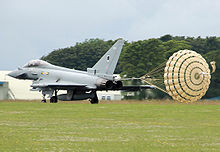

Annular and pull-down apex types
A variation on the round parachute is the pull down apex parachute. Invented by a Frenchman named Pierre-Marcel Lemoigne[20][21][22][citation needed], it is referred to as a Para-Commander canopy in some circles, after the first model of the type. It is a round parachute, but with suspension lines to the canopy apex that applies load there and pulls the apex closer to the load, distorting the round shape into a somewhat flattened or lenticular shape.
Some designs have the fabric removed from the apex to open a hole through which air can exit, giving the canopy an annular geometry. They also have decreased horizontal drag due to their flatter shape and, when combined with rear-facing vents, can have considerable forward speed.
Rogallo wing and other types
Sport parachuting has experimented with the Rogallo wing, among other shapes and forms. These were nearly always an attempt to increase the forward speed and reduce the landing speed offered by the other options at the time. The ram-air parachute's development and the subsequent introduction of the sail slider to slow deployment reduced the level of experimentation in the sport parachuting community. The parachutes are also hard to build.
Ribbon and ring parachutes have similarities to annular designs. They are frequently designed to deploy at supersonic speeds. A conventional parachute would instantly burst upon opening at such speeds. Ribbon parachutes have a ring-shaped canopy, often with a large hole in the centre to release the pressure. Sometimes the ring is broken into ribbons connected by ropes to leak air even more. These large leaks lower the stress on the parachute so it does not burst or shred when it opens. Ribbon parachutes made of kevlar are used on nuclear bombs such as the B61 and B83.
Ram-air types
Most modern parachutes are self-inflating "ram-air" airfoils known as a parafoil that provide control of speed and direction similar to paragliders. Paragliders have much greater lift and range, but parachutes are designed to handle, spread and mitigate the stresses of deployment at terminal velocity. All ram-air parafoils have two layers of fabric; top and bottom, connected by airfoil-shaped fabric ribs to form "cells." The cells fill with high pressure air from vents that face forward on the leading edge of the airfoil. The fabric is shaped and the parachute lines trimmed under load such that the ballooning fabric inflates into an airfoil shape. This airfoil is sometimes maintained by use of fabric one-way valves called Airlocks. The first Ram-air test jump was made by Navy test jumper Joe Crotwell.
Personal parachutes
Deployment
Reserve parachutes usually have a ripcord deployment system, which was first designed by Theodore Moscicki, but most modern main parachutes used by sports parachutists use a form of hand-deployed pilot chute. A ripcord system pulls a closing pin (sometimes multiple pins), which releases a spring-loaded pilot chute, and opens the container; the pilot chute is then propelled into the air stream by its spring, then uses the force generated by passing air to extract a deployment bag containing the parachute canopy, to which it is attached via a bridle. A hand-deployed pilot chute, once thrown into the air stream, pulls a closing pin on the pilot chute bridle to open the container, then the same force extracts the deployment bag. There are variations on hand-deployed pilot chutes, but the system described is the more common throw-out system.
Only the hand-deployed pilot chute may be collapsed automatically after deployment—by a kill line reducing the in-flight drag of the pilot chute on the main canopy. Reserves, on the other hand, do not retain their pilot chutes after deployment. The reserve deployment bag and pilot chute are not connected to the canopy in a reserve system. This is known as a free-bag configuration, and the components are often lost during a reserve deployment.
Occasionally, a pilot chute does not generate enough force either to pull the pin or to extract the bag. Causes may be that the pilot chute is caught in the turbulent wake of the jumper (the "burble"), the closing loop holding the pin is too tight, or the pilot chute is generating insufficient force. This effect is known as "pilot chute hesitation," and, if it does not clear, it can lead to a total malfunction, requiring reserve deployment.
Paratroopers' main parachutes are usually deployed by static lines that release the parachute, yet retain the deployment bag that contains the parachute—without relying on a pilot chute for deployment. In this configuration the deployment bag is known as a direct-bag system, in which the deployment is rapid, consistent, and reliable.
Varieties of personal ram-airs
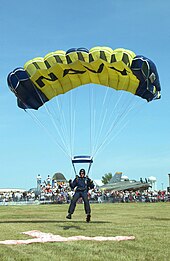
Personal ram-air parachutes are loosely divided into two varieties: rectangular or tapered, commonly referred to as "squares" or "ellipticals" respectively. Medium-performance canopies (reserve-, BASE-, canopy formation-, and accuracy-type) are usually rectangular. High-performance, ram-air parachutes have a slightly tapered shape to their leading and/or trailing edges when viewed in plan form, and are known as ellipticals. Sometimes all the taper is in the leading edge (front), and sometimes in the trailing edge (tail).
Ellipticals are usually used only by sports parachutists. Ellipticals often have smaller, more numerous fabric cells and are shallower in profile. Their canopies can be anywhere from slightly elliptical to highly elliptical—indicating the amount of taper in the canopy design, which is often an indicator of the responsiveness of the canopy to control input for a given wing loading, and of the level of experience required to pilot the canopy safely.
The rectangular parachute designs tend to look like square, inflatable air mattresses with open front ends. They are generally safer to operate because they are less prone to dive rapidly with relatively small control inputs, they are usually flown with lower wing loadings per square foot of area, and they glide more slowly. They typically have a less-efficient glide ratio.
Wing loading of parachutes is measured similarly to that of aircraft: comparing the number of pounds (exit weight) to square footage of parachute fabric. Typical wing loadings for students, accuracy competitors, and BASE jumpers are less than one pound per square foot—often 0.7 pounds per square foot or less. Most student skydivers fly with wing loadings below one pound per square foot. Most sport jumpers fly with wing loadings between 1.0 and 1.4 pounds per square foot, but many interested in performance landings exceed this wing loading. Professional Canopy pilots compete at wing loadings of 2 to 3+ pounds per square foot. While ram-air parachutes with wing loadings higher than four pounds per square foot have been landed, this is strictly the realm of professional test jumpers.
Smaller parachutes tend to fly faster for the same load, and ellipticals respond faster to control input. Therefore, small, elliptical designs are often chosen by experienced canopy pilots for the thrilling flying they provide. Flying a fast elliptical requires much more skill and experience. Fast ellipticals are also considerably more dangerous to land. With high-performance elliptical canopies, nuisance malfunctions can be much more serious than with a square design, and may quickly escalate into emergencies. Flying highly loaded, elliptical canopies is a major contributing factor in many skydiving accidents, although advanced training programs are helping to reduce this danger.
High-speed, cross-braced parachutes such as the Velocity, VX, XAOS and Sensei have given birth to a new branch of sport parachuting called "swooping." A race course is set up in the landing area for expert pilots to measure the distance they are able to fly past the 5-foot (1.5 m) tall entry gate. Current world records exceed 600 feet (180 m).
Aspect ratio is another way to measure ram-air parachutes. Aspect ratios of parachutes are measured the same way as aircraft wings, by comparing span with chord. Low aspect ratio parachutes (i.e. span 1.8 times the chord) are now limited to precision landing competitions. Popular precision landing parachutes include Jalbert (now NAA) Para-Foils and John Eiff's series of Challenger Classics. While low aspect ratio parachutes tend to be extremely stable—with gentle stall characteristics—they suffer from steep glide ratios and small "sweet spots" for timing the landing flare.
Medium aspect ratio (i.e. 2.1) parachutes are widely used for reserves, BASE, and canopy formation competition because of their predictable opening characteristics. Most medium aspect ratio parachutes have seven cells.
High aspect ratio parachutes have the flattest glide and the largest "sweet spots" (for timing the landing flare) but the least predictable openings. An aspect ratio of 2.7 is about the upper limit for parachutes. High aspect ratio canopies typically have nine or more cells. All reserve ram-air parachutes are of the square variety, because of the greater reliability, and the less-demanding handling characteristics.
General characteristics of ram-airs
Main parachutes used by skydivers today are designed to open softly. Overly rapid deployment was an early problem with ram-air designs. The primary innovation that slows the deployment of a ram-air canopy is the slider; a small rectangular piece of fabric with a grommet near each corner. Four collections of lines go through the grommets to the risers (risers are strips of webbing joining the harness and the rigging lines of a parachute). During deployment, the slider slides down from the canopy to just above the risers. The slider is slowed by air resistance as it descends and reduces the rate at which the lines can spread. This reduces the speed at which the canopy can open and inflate.
At the same time, the overall design of a parachute still has a significant influence on the deployment speed. Modern sport parachutes' deployment speeds vary considerably. Most modern parachutes open comfortably, but individual skydivers may prefer harsher deployment.
The deployment process is inherently chaotic. Rapid deployments can still occur even with well-behaved canopies. On rare occasions deployment can even be so rapid that the jumper suffers bruising, injury, or death. Reducing the amount of fabric decreases the air resistance. This can be done by making the slider smaller, inserting a mesh panel, or cutting a hole in the slider.
Safety
A parachute is carefully folded, or "packed" to ensure that it will open reliably. If a parachute is not packed properly it can result in death because the main parachute might fail to deploy correctly or fully. In the U.S. and many developed countries, emergency and reserve parachutes are packed by "riggers" who must be trained and certified according to legal standards. Sport skydivers are always trained to pack their own primary "main" parachutes.
Parachutes can malfunction in several ways. Malfunctions can range from minor problems that can be corrected in-flight and still be landed, to catastrophic malfunctions that require the main parachute to be cut away using a modern 3-ring release system, and the reserve be deployed. Most skydivers also equip themselves with small barometric computers (known as an AAD or automatic activation device like Cypres, FXC or Vigil) that will automatically activate the reserve parachute if the skydiver himself has not deployed a parachute to reduce his rate of descent by a preset altitude.
Exact numbers are difficult to estimate, but approximately one in a thousand sports main parachute openings malfunction, and must be cut away, although some skydivers have many hundreds of jumps and never cut away. Reserve parachutes are packed and deployed differently. They are also designed more conservatively, and are built and tested to more exacting standards, making them more reliable than main parachutes. However, the primary safety advantage of a reserve chute comes from the probability of an unlikely main malfunction being multiplied by the even less likely probability of a reserve malfunction. This yields an even smaller probability of a double malfunction, although the possibility of a main malfunction that cannot be cut away causing a reserve malfunction is a very real risk. In the U.S., the average fatality rate is considered to be about 1 in 80,000 jumps.[citation needed] Most injuries and fatalities in sport skydiving occur under a fully functional main parachute because the skydiver made an error in judgment while flying the canopy—resulting in high-speed impact with the ground, impact with a hazard on the ground that might otherwise have been avoided, or collision with another skydiver under canopy. [citation needed]
Parachute malfunctions

Below are listed malfunctions specific to round-parachutes. For malfunctions specific to square parachutes, see Malfunction (parachuting).
- A "Mae West" or "Blown Periphery" is a type of round parachute malfunction which contorts the shape of the canopy into the appearance of a brassiere, presumably one outward, is blown against the opposite skirt. The column of nylon fabric, buffeted by the wind, rapidly heats from friction and fuses together, removing any chance of the canopy opening.
- An "inversion" occurs when one skirt of the canopy blows between the suspension lines on the opposite side of the parachute and then catches air. That portion then forms a secondary lobe with the canopy inverted. The secondary lobe grows until the canopy turns completely inside out.
- A "Barber's pole" describes having a mess of lines tangled “behind your head and you have to cut away your main chute and pull your reserve.”[23]
- The "Horseshoe" Is an out of sequence deployment. This is when the parachute lines and bag are released before the bag drogue and bridle. This can cause the lines to become tangled or a situation where the parachute drogue not release from the container.[23]
- "Jumper-In-Tow" involves a static line which doesn't disconnect and "you are being dragged along in the wild blue yonder."[23]
- The "Streamer" is "dreaded" when the main chute is whistling in the wind, the chutist cuts away, and attempts to open the reserve if there is time.[23]
Records
On 16 August 1960, Joseph Kittinger, in the Excelsior III test jump, set the previous world record for the highest parachute jump. He jumped from a balloon at an altitude of 102,800 feet (31,333 m) (which was also a manned balloon altitude record at the time). A small stabilizer chute deployed successfully, and Kittinger fell for 4 minutes and 36 seconds,[24] also setting a still-standing world record for the longest parachute free-fall, if falling with a stabilizer chute is counted as free-fall. At an altitude of 17,500 feet (5,300 m), Kittinger opened his main chute and landed safely in the New Mexico desert. The whole descent took 13 minutes and 45 seconds.[25] During the descent, Kittinger experienced temperatures as low as −94 °F (−70 °C). In the free-fall stage, he reached a top speed of 614 mph (988 km/h or 274 m/s).[26]
Felix Baumgartner has broken Joseph Kittinger's record with a jump from an altitude of over 128,000 feet.
According to the Guinness book of records, Eugene Andreev (USSR) holds the official FAI record for the longest free-fall parachute jump (without drogue chute) after falling for 80,380 ft (24,500 m) from an altitude of 83,523 ft (25,457 m) near the city of Saratov, Russia on 1 November 1962.
See also
References
- ^ a b White 1968, p. 466
- ^ a b White 1968, pp. 462f.
- ^ a b c d White 1968, p. 465
- ^ White 1968, pp. 465f.
- ^ BBC: Da Vinci's Parachute Flies (2000); FoxNews: Swiss Man Safely Uses Leonardo da Vinci Parachute (2008)
- ^ aero.com
- ^ a b De Prins der Geillustreerde Bladen, February 18, 1911, p. 88-89.
- ^ a b c d e Parachuting at the site Divo: The Russian Book of records and achievements Template:Ru icon
- ^ United States Patent US1108484 Available on-line at: http://www.freepatentsonline.com/1108484.pdf .
- ^ Ritter, Lisa (2010), "Pack Man", Air & Space, 25 (1): 68–72
{{citation}}: Unknown parameter|month=ignored (help) - ^ May 1931, Popular Mechanics photo of observation balloon gondola with external bag parachutes used by British Royal Navy
- ^ Lee, Arthur Gould (1968), No parachute, London: Jarrolds, ISBN 0-09-086590-1
- ^ Aviatory Life Buoy - Patent # 1192479, July 25, 1916, held by inventor Solomon Lee Van Meter, Jr http://www.vanmetre.com/Misc/Life_Buoy.pdf
- ^ Kentucky Aviation Pioneers Solomon Lee Van Meter Jr. (1888-1937), KET Aviation Museum Of Kentucky
- ^ [1]
- ^ [2]
- ^ Russian parachute of Kotelnikov Template:Ru icon
- ^ Dr L. de Jong, 'Het Koninkrijk der Nederlanden in de Tweede Wereldoorlog', (Dutch language) part 3, RIOD, Amsterdam, 1969
- ^ Dr L. de Jong, 'Het Koninkrijk der Nederlanden in de Tweede Wereldoorlog', (Dutch language) part 10a-II, RIOD, Amsterdam, 1980
- ^ Pierre Marcel Lemoigne, U.S. patent no. 3,228,636 (filed: 7 November 1963; issued: 11 January 1966). Available on-line at: http://www.google.com/patents?id=XcxVAAAAEBAJ&pg=PA1&zoom=4&ie=ISO-8859-1&output=html .
- ^ French Web site on recent work on parachutes (in French): http://jmp-pan.blogspot.com/2008/02/historique-du-parachutisme-ascensionnel_988.html . Includes photo of Mr. Lemoigne.
- ^ See also: Theodor W. Knacke, "Technical-historical development of parachutes and their applications since World War I (Technical paper A87-13776 03-03)," 9th Aerodynamic Decelerator and Balloon Technology Conference (Albuquerque, New Mexico; 7–9 October 1986) (N.Y., N.Y.: American Institute of Aeronautics and Astronautics, 1986), pages 1-10.
- ^ a b c d Scott Royce E. "Bo". Jump School at Fort Benning (originally published in a column called DUSTOFF in the July - August 1988 Issue of the Screaming Eagle Magazine)
- ^ Jeffrey S. Hampton (2003-12-15). "'Hero of Aviation' speaks about record-setting free fall". The Virginian-Pilot. p. Y1.
- ^ Tim Friend (1998-08-18). "Out of thin air His free fall from 20 miles (32 km) put NASA on firm footing". USA Today. p. 1D.
- ^ Data of the stratospheric balloon launched on 8/16/1960 For EXCELSIOR III
Sources
- White, Lynn (1968), "The Invention of the Parachute", Technology and Culture, 9 (3): 462–467, doi:10.2307/3101655, JSTOR 3101655
External links
- CSPA The Canadian Sport Parachuting Association—The governing body for sport skydiving in Canada.
- Excelsior III free-fall from a Stratospheric Balloon, Details of the highest parachute jump ever.
- FAI The Federation Aeronautique Internationale—The international governing body for all airborne sports.
- First jump with parachute from moving plane - Scientific American June 7, 1913.
- Parachute
- Parachute History
- Program Executive Office (PEO) Soldier
- Skydiving education
- The 2nd FAI World Championships in Canopy Piloting - 2008 at Pretoria Skydiving Club South Africa
- USPA The United States Parachute Association—The governing body for sport skydiving in the U.S.
- The Parachute History Collection at Linda Hall Library (text-searchable PDFs)
- "How Armies Hit The Silk" June 1945, Popular Science James L. H. Peck - i.e. detailed article on parachutes
